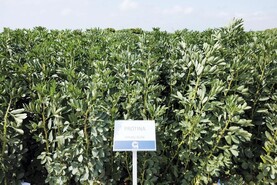Spring beans area increased by about 800ha this year. More farmers are moving to the crop which offers an opportunity to cut out artificial nitrogen use.
Some growers also take the chance to cut out ploughing for the year and plant the seed deep, to keep away crows, with a direct drill. Very importantly, it allows for different weed control for problem weeds that are difficult to control in cereal crops, for example.
Lynx remains the dominant variety with 70% of the seed (see Table 1). Lynx is well known at this stage. It’s the highest-yielding bean in Department trials, with a relative yield score of 102.
Its crude protein score is 100. It scores well on lodging and brackling resistance, at nine and eight respectively.

Caprice.
Caprice, with 18% of the seed, scores a 99 on relative yield and 102 for protein. It’s the same height as Lynx at 132cm and is slightly ahead on disease resistance, with a score of six for resistance to rust.
Protina beans will make up 8% of the seed next season. They have a protein content of about 24.9% compared to other varieties at about 23.9%. It has good stems, scoring an eight for resistance to lodging and a seven for resistance to brackling.

Protina.
Victus isn’t as good to stand as Lynx. It scores 99 for relative yield and 100 for relative protein content.
The variety scores a seven for resistance to both chocolate spot and downy mildew. Victus takes up 3% of the seed area this year.
Vire is another variety in seed production. It takes up less than 1% of the seed area this year.
Spring beans area increased by about 800ha this year. More farmers are moving to the crop which offers an opportunity to cut out artificial nitrogen use.
Some growers also take the chance to cut out ploughing for the year and plant the seed deep, to keep away crows, with a direct drill. Very importantly, it allows for different weed control for problem weeds that are difficult to control in cereal crops, for example.
Lynx remains the dominant variety with 70% of the seed (see Table 1). Lynx is well known at this stage. It’s the highest-yielding bean in Department trials, with a relative yield score of 102.
Its crude protein score is 100. It scores well on lodging and brackling resistance, at nine and eight respectively.

Caprice.
Caprice, with 18% of the seed, scores a 99 on relative yield and 102 for protein. It’s the same height as Lynx at 132cm and is slightly ahead on disease resistance, with a score of six for resistance to rust.
Protina beans will make up 8% of the seed next season. They have a protein content of about 24.9% compared to other varieties at about 23.9%. It has good stems, scoring an eight for resistance to lodging and a seven for resistance to brackling.

Protina.
Victus isn’t as good to stand as Lynx. It scores 99 for relative yield and 100 for relative protein content.
The variety scores a seven for resistance to both chocolate spot and downy mildew. Victus takes up 3% of the seed area this year.
Vire is another variety in seed production. It takes up less than 1% of the seed area this year.








 This is a subscriber-only article
This is a subscriber-only article










SHARING OPTIONS: